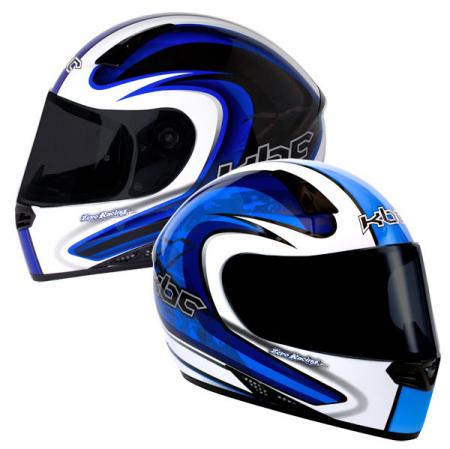In the world of budget helmets there are a myriad of choices on the market today, but many are from fly-by-night companies with no reputation for safety, quality control or name recognition. It’s a tough decision for new riders looking at this price category, as they likely haven’t heard any of the brand names the salesman is mentioning, which makes the distinction between a bargain and a safety hazard that much more difficult to distinguish.
KBC, the Korean helmet manufacturer with a long-standing history in the U.S. market for producing both higher-end and budget helmets, has just released its newest lid — the V Zero — aimed directly at the rider looking to pinch pennies. The most attractive feature about the V Zero is its price. Starting at just $104 for a solid color, it’s one of the most affordable full-face helmets we would actually feel comfortable wearing. An asymmetrical red, blue, or gray graphic version only costs $10 more. While appearance is a subjective matter, we think they look pretty good.
Shell material on the KBC V Zero is a lightweight ABS plastic composite combined with aramid epoxy resins (similar to that seen on hard-shell luggage), while a dual-layer EPS liner absorbs the bulk of the impact should you take a fall. Integrated into the EPS are ventilation channels that run along the two upper vents and the single, large chin vent. Inside, the V Zero features what KBC calls a “Duralux” fully removable and washable liner and cheek pads.
Long-oval heads will appreciate the fit of the V Zero, as it’s definitely longer front to back than my intermediate-oval head. E-i-C Duke also confirmed its extra length. Side-to-side fitment is comfortable for my noggin, as is the felt-like liner, but Duke wished the ear pockets were a little larger. KBC says the padding will break-in over time, forming to the rider’s head, which should alleviate some of this discomfort. Or, if you can’t wait, different padding of varying thickness is available for a custom fit. As with any motorcycle helmet, try it on yourself to confirm a proper fit.
Shield replacement is easy on the V Zero, as it incorporates KBC’s “One-Touch” shield release system as seen on the rest of the KBC line. Pulling two tabs, one on either side of the shield, frees it for removal. Replacing the shield is as simple as lining up each tab in its upper-most position and snapping it into place. The “Perfect-Seal” ratchet system allows the shield to open incrementally and, as the name implies, creates a perfect seal when closed, not allowing any air to enter when riding. The shield is also Pinlock-ready, meaning the rider can replace various inserts to achieve the same effect as replacing faceshields.
The rather simplistic shape of the V Zero, combined with the lack of intricate shield attachment mechanisms or aerodynamic add-ons, helps keep its weight to 3.3 pounds, which is average in the world of helmets. Also, note that the 2012 V Zero is not only D.O.T.-approved but also meets or exceeds ECE R 22.05 standards. Our 2011 version, however, is only D.O.T.-approved.
The V Zero allows some turbulent air to come through the chin area, though it’s less than past KBC helmets I’ve sampled. A chin curtain is available, but it wasn’t included in the particular unit I sampled. Duke’s was, but he says it doesn’t solve the turbulent air issue.
Aerodynamically, it flows through the air at highway speeds without much strain on the neck, though the same can’t be said once you turn to the side. Field of view from the eyeport is impressive, especially at the racetrack, as you can hang off the side of the bike (if that’s your style) with ample field of vision from the upper portion of the eyeport.
Of course, you’d expect a helmet at this price to have a few downsides. First off, the KBC V Zero is loud. Wind, road and engine noise all find ways to make it to the ear canals, possibly more so than any helmet I’ve worn in recent memory. Further, the double D-Ring closures (and the pull tab that helps loosen the strap) aren’t fixed in place. This is annoying because the rings can spin from their intended configuration and can get tangled when trying to tighten the helmet or become difficult to loosen when trying to take the helmet off. Lastly, while the V Zero is vented, there is a negligible difference in air flow with the vents opened or closed. Mostly, the open vents just added a whistling noise that was a bit annoying.
Overall, it’s hard to fault the V Zero, especially considering its price point. It’s a comfortable helmet that stands out in a sea of budget lids for being well made and attractive. Despite its minor setbacks, we wouldn’t hesitate to recommend the V Zero to anyone looking for an inexpensive helmet to use for the daily grind or as a backup for a pillion. For more information.
Related Reading
2011 Arai Signet-Q Helmet Review
2011 KBC VR4R Helmet Review
Shoei RF1100 Helmet Review
2011 Shoei Qwest Helmet Review
2010 Arai Corsair V Helmet Review
Buyer’s Guide to Motorcycle Helmets
 6:12 AM
6:12 AM
 Chiken Joe
Chiken Joe





 Posted in:
Posted in: 







0 comments:
Post a Comment